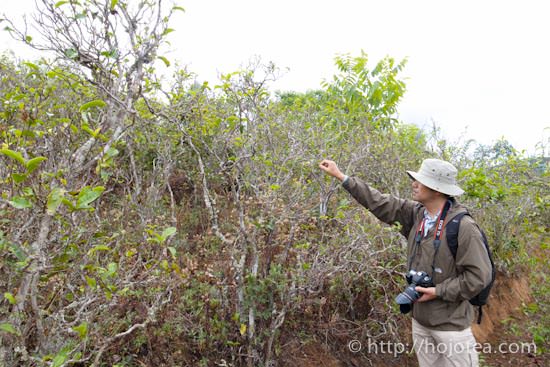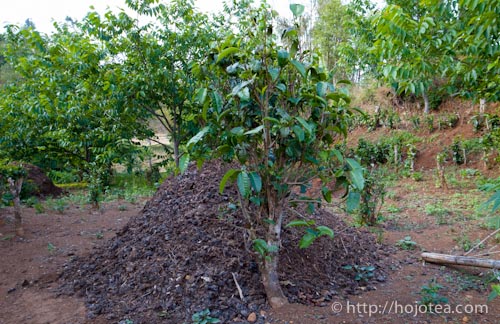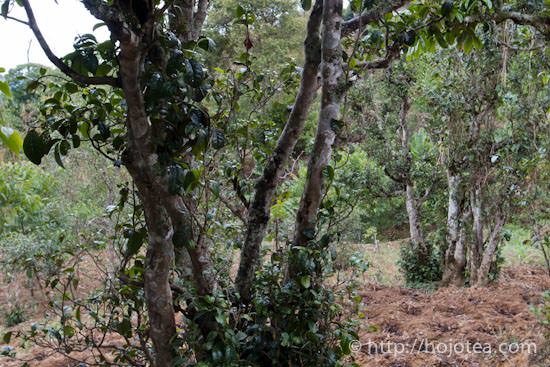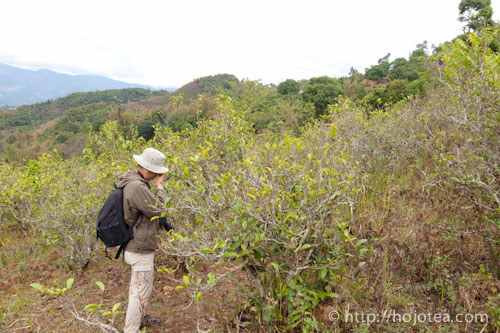- HOME >
- How to choose quality tea
Tips on Tea Quality Inspection
- [2013.03.22] Posted By Akira Hojo
There are many ways to judge the quality of tea. Among all, I would like to introduce one method: to check the unrolling speed of brewed leaf. The high quality leaf unroll very fast, while the poor quality leaf takes a long time to unroll, or sometimes it does not perfectly unroll. I would like to explain why this phenomenon occurs.
Nitrogen boost the growing speed of tea
Regardless of tea or other agricultural plants like fruit and vegetable, the plants must grow slowly in order to produce thick, smooth and strong after taste. The natural plant does not grow as fast as the artificial plant. If you look at the natural plant, you may notice that the colour of leaves is not very green; it’s yellowish. If nitrogen-based fertilizer is added, plant grows quickly. When plant grows faster, it forms more cell walls and the cells become bigger. It also forms other necessary constituents, e.g., the quantity of chlorophylls increase and leaf becomes green in colour. When leaf grows excessively, the tea leaf becomes bigger size not because it increases the number of cell, but the size of cell. Eventually, tea leaf contains very less constituents, and the tea processed from the big leaf tastes very light and flat.
My father used to tell me about the same story regarding his apple. He said that there were a number of farmers who applied a lot of fertilizers in order to make the apple grow bigger and increase the output. In fact, it is very easy to tell if apple is grown with a lot of fertilizers. Its taste becomes very thin, watery and less body.
On the contrary, the tea grown under the harsh environment without fertilizer or pesticide produces very small leaf; leaf is thick, elastic and yellow in colour. Despite tea leaf is so small, it consists of a huge number of tiny cells.

The garden managed follow the natural farming method
The dark green and large leaf
One of the processing steps of tea is rolling. After the rolling process, there is a noticeable difference between large-dark green leaf and small-yellow leaf. The large leaves are easily cracked as each cell is too big. If the cells are so big, it is mechanically weak. It is just like a building with pillars that are too long.
On the contrary, the naturally grown leaf is very elastic and strong as it consists of a huge number of tiny cells. The cells of small leaf never get cracked no matter how much it is rolled. In fact, big tea leaf is very weak even when it is fresh; it easily cracked when I rolled it on my palm. As for the yellow and small leaf, it is very elastic and strong. I can hardly crack it and it’s like a rubber.
Besides, the elasticity of tea leaf is related to the amount of dust generated during tea processing. If tea leaf has a huge number of tiny cells, it generates very less dust during processing. Most of the tea leaves remain intact due to its elasticity.
You can see many broken leaf. (The one on the right is the last year crop. So please ignore that the colour of leaf is slightly more yellowish)
You can see that for the leaf on the right, there is no broken leaf, thick and looks so elastic; its quality is much better than the tea on the left.
The cell wall of poor tea is cracked during rolling process. When it is brewed, it does not unrolled swiftly since it is cracked. It takes a long time to unroll or sometimes it doesn’t fully unroll even after several brewing. The cracked leaf cannot reverse just like it is no use crying over spilt milk. As for high quality leaf, once the hot water is poured onto the leaf, it unrolls briskly to its original leaf shape. This is one of the important indexes to observe the quality tea.
The only exceptional is the heavily-roasted tea. Regardless of high or low quality tea, the leaf takes a longer time to unroll as it has been deeply-heated during baking.
Related Articles
How to get the latest update on HOJO?
1. Follow Twitter, 2. Click "Like" on Facebook, and 3. Subscribe in newsletter. You can have the latest tea news from HOJO.
 Subscribe the Newsletter to enjoy the privileges
Subscribe the Newsletter to enjoy the privileges- You may receive a free sample upon purchase, or you may have the priority to purchase special products. So please remember to subscribe our newsletter as well as the social network.
- Myanmar White Tea Bud 2013 from Guo Gan, Myanmar
- We have released a raw Pu-erh tea, 緬甸白芽茶 2013 (Myanmar White Tea Bud 2013), produced by ethnic minorities in t …
- Yong De Wild White Tea 2025 Loose Leaf Limited Release
- We have released Yong De Wild White Tea Loose 2025. For the 2025 harvest, only the loose-leaf type was …
NEW ARTICLES
 Myanmar White Tea Bud 2013 from Guo Gan, Myanmar
Myanmar White Tea Bud 2013 from Guo Gan, Myanmar- We have released a raw Pu-erh tea, 緬甸白芽茶 2013 (Myanmar White Tea Bud 2013), produced by ethnic minorities in t …
 Yong De Wild White Tea 2025 Loose Leaf Limited Release
Yong De Wild White Tea 2025 Loose Leaf Limited Release- We have released Yong De Wild White Tea Loose 2025. For the 2025 harvest, only the loose-leaf type was …
 Experience the True Freshness of Raw Pu-erh : Tang Jia 2025 Loose Leaf Release
Experience the True Freshness of Raw Pu-erh : Tang Jia 2025 Loose Leaf Release- We have released Tang Jia Raw Pu-erh Tea 唐家古樹生茶 2025 Loose Leaf. Among HOJO’s raw pu-erh teas, Tang Jia Raw Pu …
 Yunnan Chun Jian Green Tea from High Mountain Gardens
Yunnan Chun Jian Green Tea from High Mountain Gardens- Yunnan Chun Jian Green Tea is now available. This tea is made from naturally grown leaves harvested from high …
 Limited Loose Leaf Release of 2025 Da Xue Shan Wild Raw Pu-erh Tea
Limited Loose Leaf Release of 2025 Da Xue Shan Wild Raw Pu-erh Tea- We have released the 2025 loose-leaf version of Da Xue Shan Wild Raw Pu-erh Tea. This tea comes from wild tea …
 Discover a New Way to Enjoy Tea: Cooking Rice with Tea
Discover a New Way to Enjoy Tea: Cooking Rice with Tea- Cooking rice with tea is a simple idea, but it brings surprisingly satisfying results. The tea’s flavour seeps …
 2025 Da Xue Shan Wild White Tea Now Available from Yunnan
2025 Da Xue Shan Wild White Tea Now Available from Yunnan- The 2025 harvest of Da Xue Shan Wild White Tea is now available. Crafted from truly wild Camellia taliensis tr …
 Fresh 2025 Yunnan White Tea – Select Your Favourite Lot Before Blending
Fresh 2025 Yunnan White Tea – Select Your Favourite Lot Before Blending- Freshly crafted in Yunnan and just arrived in KL, our new 2025 white tea is now available at our Gardens Mall …
 2024 Dong Shan Raw Pu-erh Tea – Crafted with the Producer for Desired Quality
2024 Dong Shan Raw Pu-erh Tea – Crafted with the Producer for Desired Quality- We have released the 2024 cake of Dong Shan Raw Pu-erh Tea. Earlier, we offered the loose-leaf version from th …
 Development of Firewood Roasted Hojicha Using Naturally Grown Tea from Yunnan
Development of Firewood Roasted Hojicha Using Naturally Grown Tea from Yunnan- We are currently staying in Yunnan Province for tea production. As the season nears its end, tea trees with pa …
Category
- New Arrival at HOJO Online Shop
- Featured Articles
- Newsletter
- Types of Tea
- Origin of Tea
- Teapot and Tea Equipment
- Tea Column
- How to enjoy tea
- Tea Processing
- How to choose quality tea
- Tea constituents and functional effect
- Safety of Tea
- Foods
- Tea Business Operation
- Hobby and Outdoor Activity
- Ranking of Tea
- Video
- FAQ
- Media Release
Profile

- AKIRA HOJO
- I invite you to experience my tea selections.I was born in Nagano, Japan. In university, I studied agricultural chemistry, and I have the master degree in food science. I worked in Japanese food industry for 10 years. I involved in R&D, QC and QA. As a factory manager, I implemented ISO9000 series and managed the factory.
- The Art of Tea Magazine
- We posted the article on “The Art of Tea Magazine No.9, the magazine is published in Taiwan. We featured …
- New Straits Times
- The Malaysian National Newspaper, New Straits Times featured HOJO Tea on 17-Oct-2007.
Shop Info

Address:Lot No. T-215, 3rd Floor, The Gardens Mall, Mid Valley City, Lingkaran Syed Putra, 59200 Kuala Lumpur
Tel: +603-2287-4537
Business Hour: 10am to 10pm



















